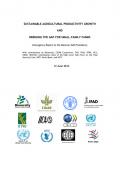
Early in 2012 Mexico, as G20 President, invited international organisations to examine practical actions that could be undertaken to sustainably improve agricultural productivity growth, in particular on small family farms. The preparation of this report, co-ordinated by the FAO and the OECD, is a collaborative undertaking by Bioversity, CGIAR Consortium, FAO, IFAD, IFPRI, IICA, OECD, UNCTAD, Coordination team of UN High Level Task Force on the Food Security Crisis, WFP, World Bank, and WTO. The recommendations provided are broadly of two types: specific actions that can contribute in some way to improving productivity growth or sustainable resource use (whether building on existing initiatives or suggesting new activities) and more general proposals that may not be actionable as presented but that serve to highlight areas for priority attention.
This report examines how green growth and sustainable development policies can be incorporated into structural reform agendas. Indeed, as demonstrated in the report, many of these policies are closely linked and synergistic with the framework policies applied by G20 governments in their efforts to pursue strong and sustainable growth.
Climate change is one of the most pressing threats to development today. Addressing climate change requires that countries take an integrated approach to climate and development planning so that policies and actions across multiple sectors and scales facilitate the adaption to climate change and deliver poverty reduction gains. An important tool for countries to manage climate finance is the National Climate Fund (NCF). NCFs are nationally-driven and nationally-owned funds that help countries to collect climate finance from a variety of sources, coordinate them, blend them together and account for them. This guidebook is part of a series of practical guidance documents and toolkits to support national and sub-national governments to achieve low-emission, climate-resilient development. It is based on UNDP’s decades of experience in delivering climate change programming in order to help countries design and establish an NCF.
The guide presents the following as key goals of NCFs:
•collect sources of funds and direct them toward climate change activities that promote national priorities
This edition of the Southeast Asian Economic Outlook examines the macroeconomic situation, policies and medium-term growth prospects for countries in the region; structural challenges; green growth strategies, policies and institutions; and environmental taxes. It finds that growth for the region will moderate in the near term but solid growth performance will continue until 2016. To sustain this favourable outlook, countries need to meet considerable structural challenges. Green growth offers an alternative growth strategy in the long term.
The principles of sustainable development play an integral role in making development assistance work at the level of policies, plans and programmes. In response to the Paris Declaration call to "… develop and apply common approaches for ‘Strategic Environmental Assessment’ at sector and national levels" among donors and partners, the Guidance on Applying Strategic Environmental Assessment was endorsed in 2006 by members of the OECD Development Assistance Committee, representatives of developing countries receiving aid, the United Nations Development Programme, the United Nations Environment Programme, the World Bank and many other agencies. Since then, a growing number of countries at all levels of development have legislation or regulations prescribing the application of Strategic Environmental Assessment (SEA) and many more are introducing it as part of their policy tools. This is creating unique opportunities for better policy making and planning by incorporating environmental considerations into high-level decision-making and opening new mechanisms to build consensus on development priorities within governments themselves and between governments and societies.
The primary objective of this study is to design an integrated strategy, based on government criteria and expert assessment, for the transformation of the economy of Carriacou and Petite Martinique into a greener and more sustainable economy. The study seeks to design an approach for a transition to sustainable development for Carriacou and Petite Martinique according to criteria specified by government representatives and national experts. The experiences and lessons learned from this study will provide valuable information and awareness for other Small Island Developing States (SIDS). The study will generate substantive knowledge about the most important development blocks necessary for sustainable economies of SIDS with similar challenges and objectives.
Going for Growth is the OECD’s annual report highlighting developments in structural policies in OECD countries. It identifies structural reform priorities to boost real income for each OECD country and key emerging economies (Brazil, China, India, Indonesia, Russia and South Africa).
Using a computable general equilibrium, this paper quantifies the GDP and employment effects of an illustrative greenhouse gas emissions reduction policy. The paper first analyses the direct negative economic effects of the emissions restrictions on GDP and examines labour sectoral reallocations in a framework where labour markets are perfectly flexible. The model is then modified to incorporate labour market imperfections in OECD countries that could generate unemployment, namely, short-run rigidities in real wage adjustment. It is shown that imperfect wage adjustment increases the cost of mitigation policy since unemployment increases in the short-run, but that the carbon tax revenue generated can be recycled so as offset some or all of this effect, notably when it is used to reduce wage-taxes. Thus, taking realistic labour market imperfections into account in a CGE model affects the GDP costs of mitigation policy in two ways: first by introducing extra costs due to the increased unemployment that such policy may entail; second by creating the possibility of a double dividend effect when carbon taxes are recycled so as to reduce distorting taxes on labour income.
Long-term projections suggest that without policy changes, the continuation of business-as-usual economic growth and development will have serious impacts on natural resources and the ecosystem services on which human well-being depends. This highlights the necessity for both developed and developing countries to move to a new growth path that is consistent with the protection of the environment and a sustainable use of scarce natural resources, while still achieving sizeable gains in living standards and reducing poverty...

